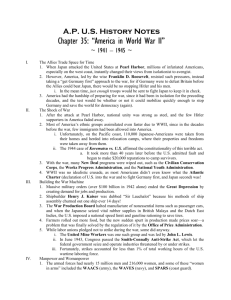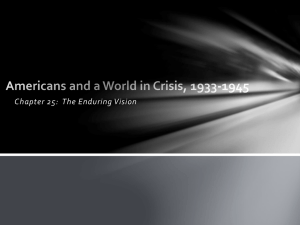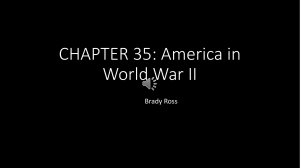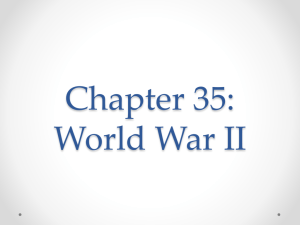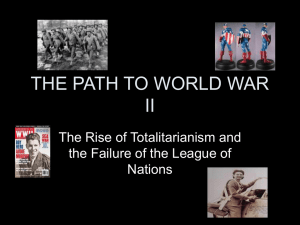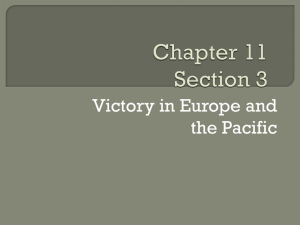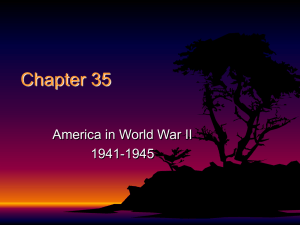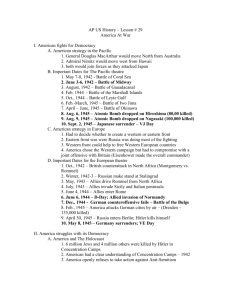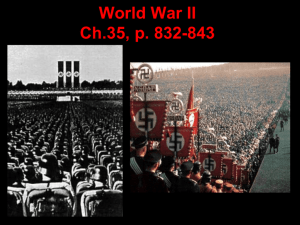WWII P2
advertisement
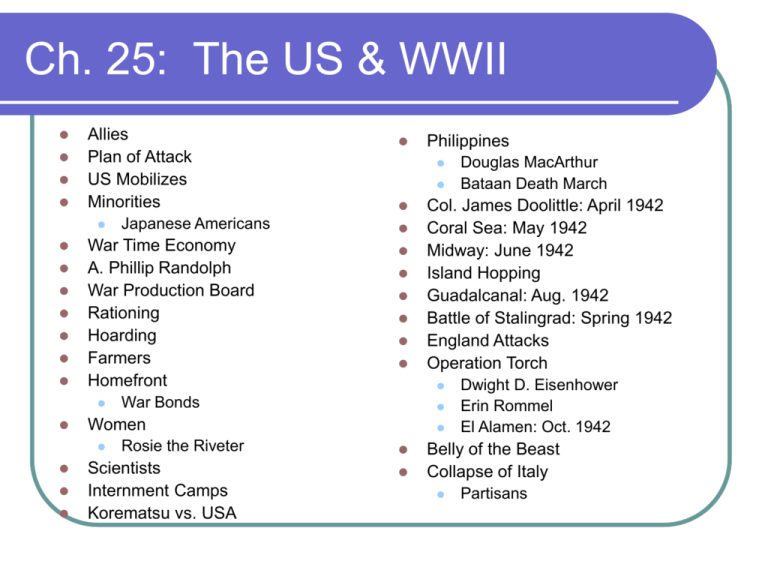
Ch. 25: The US & WWII Allies Plan of Attack US Mobilizes Minorities War Time Economy A. Phillip Randolph War Production Board Rationing Hoarding Farmers Homefront Scientists Internment Camps Korematsu vs. USA Douglas MacArthur Bataan Death March Col. James Doolittle: April 1942 Coral Sea: May 1942 Midway: June 1942 Island Hopping Guadalcanal: Aug. 1942 Battle of Stalingrad: Spring 1942 England Attacks Operation Torch War Bonds Rosie the Riveter Philippines Women Japanese Americans Dwight D. Eisenhower Erin Rommel El Alamen: Oct. 1942 Belly of the Beast Collapse of Italy Partisans Operation Overlord: D-DAY 1944 Election Battle of the Bulge V-E Day Leyte Gulf: Oct. 1944 Oppenheimer Potsdam Conference: July, 1945 Hiroshima Big 3 Agreements Manhattan Project Kamikaze Pilots Iwo Jima Okinawa Yalta Conference: Feb. 1945 Harry Truman Enola Gay Little Boy Nagasaki V-J Day Post War Info. United Nations US Joins the War After Pearl Harbor, the US joins the Allies Fall of France & attack of USSR United under “Remember Pearl Harbor!” Japanese boastful The Allies France, Britain, Soviet Union & USA Allie Plan of Attack Plan of Attack: 1. 2. Defeat Germany 1st, can’t let Hitler take over Europe THEN, worry about Japan Wanted unconditional surrender US Mobilizes US mobilized troops & economy Selective Service & changing industry Many eager to join service after Pear Harbor 8 weeks of training then off to fight Shortage of weapons, make believe training Minorities Some had problems fighting for a country in which they didn’t have equality “Here lies a black man who killed a yellow man protecting a white man!” Minorities did makes gains during WWII Segregated units 33,000 Japanese Americans (Nesei) joined US military to show loyalty; served as spies, translators etc. 25,000 Native Americans; 13,000 Chinese Americans War Time Economy Industries began to produce war materials Instead of pencils, made bombs etc. No cars, only tanks, planes etc. 140 Victory Ships per month WWII production ended the Great Depression in America A. Phillip Randolph 1941: Planned march on Washington to demand right to work in factories Companies began to hire regardless of race b/c needed workers FDR agreed to avoid march during war War Production Board Organized scrap drives for paper, rags, cooking fat, tin rubber etc. Recycled for war effort Life at Home Nat’l. speed limit reduced to conserve tires (Japan controlled rubber production areas) Rationing: Limiting goods deemed essential for war effort Used during WWII Meatless, Wheatless Rationing books Gas rationing (West) Hoarding was bad/unpatriotic Farmers increase production Billions in war bonds redeemable after war & would aid economy, no depression! Homefront America suffered less than other nations Economy boomed & employment increased More gov’t. intervention in everyday life War Bonds raised $$ to support the war effort Posters Propaganda films (video) 6 mill. enter workforce Worked in factories & replaced men in other jobs, just as in WWI 2/3 leave workforce after war b/c opportunities decline Rosie the Riveter: Nickname of women who entered workforce Over 200,000 women joined military Served as nurses, radio operators, record keepers etc. Woman’s Army Corps (WAC) WAVES, WAFS (Ferry Service) Didn’t received military benefits Weird Science Scientists play important role in war effort – medical, industrial, military etc. Pushed for penicillin, improved sonar & radar Race to Build the Bomb Einstein warned FDR of Germany’s ability to split the atom US & Germany raced to develop the world’s 1st atomic bomb Treatment of Japanese Americans Fear of Japanese rampant Lost homes, business, rights…lives Internment Camps: Prison camps for possible threats to national security (mostly Japanese) 100,000+ Surrounded by armed guards & barbed wire Southwest & South Korematsu vs. USA: 1944 Challenged internment camps; they violated 5th Amendment Supreme Court said internment camps were legal b/c necessary for national security 1965: Compensated for lost business & property George Bush issued a formal apology in 1988, granted $20K/each Japan invaded Philippines in 1942 Douglas MacArthur lead US troops stationed there Forced out by Japanese “I Will Return” Bataan Death March: Captured US troops forced to march over 50 miles to POW camp Many died (30,000) Japan controlled Philippines Disproved theory of white domination in SE Asia Col. James Doolittle April 1942 Showed Japan could be attacked by plane Japanese islands vulnerable to attack Dampened Japanese spirits & lifted US morale Coral Sea: May 1942 Japan eyeing Australia US & Australian troops stop Japanese advance (1st time) Australia not invaded New type of naval warfare: no ships, fought with airplanes from aircraft carriers Allies lost most, but Japan unable to continue, out of fuel Battle of Midway: June 1942 “US Avenged Pearl Harbor” • Led by Admiral Nimitz • US intercepted info. abt. Japanese movement toward strategic island of Midway, then off to finish Pacific Fleet in Pearl Harbor • US outnumbered 4 to 1 • US took big chance, sent bulk of Navy for this sneak attack • Worst Japanese defeat • 4 aircraft carriers, 322 planes & 1 cruiser • Turning point of Pacific Theater • Japan begins to weaken, loses power in Pacific Taking islands over one at a time, bypassing well fortified ones, to build airstrips Guadalcanal: Aug. 1942 1st land offensive of Pacific War 6 months battle Island of Death Important for use as an airstrip: toehold to attack on Japan Showed how costly this would be (30%) US moving closer to Japan Battle of Stalingrad: Spring 1942 Germany stuck on Eastern Front (Near Soviet Union) Stalingrad major Soviet industrial center, Germany needs the resources because it’s low on oil & machinery Nov. 1942-Feb. 1943 Hitler tried to take Stalingrad, burned city Soviets retaliated, fighting back in -44 weather Turning point of the European Theater (1943) • Stalin wants US & Britain to get involved with land troops ASAP • Distract German troops US upset because already lost 200,000 USSR loses that many by breakfast everyday 8 million soldiers (estimate) 16 million civilian (estimate) • Fighting Germany alone for months England Attacks England retaliates by launching bombing raids over Germany in late 1942 Retaliating for Bombing of Britain France still under attack because Britain not ready & wanted an attack on Africa US needed British aid to make attack, so went along & attacked Africa & then Italy Operation Torch: North Africa Operation Torch: Allied assault on North Africa Dwight Eisenhower (USA): Led Allied assault in N. Africa Erwin Rommel (Germany): Desert Fox Oct. 1942: El Alamen: Germany suffered major defeat & surrendered in 1943 in Tunisia Italy was the “Soft underbelly of Europe” b/c it was the weakest point to attack in Europe Collapse of Italy Allies attack Sicily first, then on to mainland King stripped Mussolini of power – “Most hated man in Italy” Italy weak after long war & surrendered in Sept. 1943 Northern Italy still under Nazi control, where Mussolini fled Mussolini captured by Partisans: Underground resistance movement Mussolini & mistress shot & strung up on display in Milan Square Allies needed France to bring in heavy machinery; ports close to Britain Kept bombing Germany to prepare for invasion Fed Germany false information, used decoys Hitler expecting Belgian invasion Allies planned to attack Normandy, France Operation Overlord D-DAY June 6, 1944: Allied invasion of Normandy, France Gen. Eisenhower in charge of Allies Largest amphibious invasion in history Problems: Drop zones, fortifications, underwater mines etc. Several beaches attacked – Omaha Beach heaviest Led to the Liberation of France By Sept. 1944, most of N. Europe was free FDR wins 4th term b/c war going well Wanted to see country through war Died April 12, 1945 Harry Truman – FDR’s VP; became the Pres. After FDR died Battle of the Bulge Dec. 1944 – Jan. 1945 Battle of Aachen: 1st German city taken Germany broke through American lines (creating bulge) 80 mile front & took 1 month to get back under Allied control; Germany defeated Germany’s last major attack Germany’s Demise 2 front war: USSR & US 1945: US & Soviet troops met in Berlin Hitler hiding in bunker with new wife & other friends April 30, 1945: Hitler shot himself, wife took poison, gave dog cyanide-bodies burned Hitler blamed Jews in final letter Victory in Europe Day May 7, 1945 1st part of war over Leyte Gulf, Philippines: Oct. 1944 Guess who made good on his promise to return to the Philippines? “People of the Philippines: I have returned!” 3 major battles take place US takes the Philippines: MacArthur in charge Islands completely taken by 1945 Japanese desperate & use Kamikaze pilots: Suicide pilots Lost 424 pilots Iwo Jima Feb.-Mar. 1945 Strategic: serve as base for heavy bombers (couldn’t take off from carriers) Most protected place on earth – 20,000 Japanese Only 200 survived Okinawa April – June 1945 Last island in US’s way to Japan Heavy Casualties: Showed possible high losses if US invaded Japan Estimated over 1,000,000 would be lost in land invasion of Japan Yalta Conference: Feb. 1945 Meeting of the Big 3 to discuss the war effort & post war reconstruction Big 3: US (FDR); Britain (Churchill) & USSR (Stalin) Agreements: USSR would enter war with Japan after 2 months Poland would have free elections & serve as a buffer btwn. Germany & USSR Creation of the United Nations Divide Germany after war Manhattan Project US began developing an atomic weapon under the code name Manhattan Project Used Uranium 235 & Plutonium 239 (rare) Scientists led by J. Robert Oppenheimer TRINITY EXPLOSION • 1st atomic weapon detonated in Los Alamos, New Mexico: 7/16/45 • 20,000 tons of TNT • Flash seen 450 miles away & heard 200 miles away • More powerful than dared hoped • Oppenheimer: “I have become Death, the shatterer of worlds, waiting that hour that ripens to their dooms.” • $20 billion to develop • 4 bombs made (1 test, 2 for war, I unused) Potsdam Conference: July 1945 Another meeting of Big 3: Truman instead of FDR ( no Churchill (out of ofc) Truman informed about atomic weapon Didn’t tell Stalin, but he knew…spies Truman told Japan to surrender or face prompt & utter destruction, but didn’t say how Called for war crimes trials after war August 6, 1945: US drops A-Bomb on Hiroshima Enola Gay: Plane which dropped 1st A-Bomb (Little Boy); 70,000 dead in blink of eye, 30,000 from radiation & injuries W/i 43 seconds, most buildings collapsed into dust Japan refused to surrender Why? Before After Aug. 9, 1945 2nd A-Bomb dropped on Japan - Fat Man 7,000 degrees Centigrade Emperor horrified & surrenders: 8/14/45 V-J Day: Victory In Japan – 8/15/45 Formal surrender: 9/2/45: USS Missouri It was perhaps unforgivable, but in fact at the time, I was completely calm & composed. In other words, it was just too much, too enormous to absorb. - Yosuke Yamahata - Nagasaki Survivor Post War Info. War crimes trials were held in Nuremberg Many Nazis & Japanese sent to prison, some death Japan under control of MacArthur who helped create constitution & improve economy Germany divided into 4 zones 300,000 Americans died, 800,000 wounded International peace keeping organization (replaces the League of Nations) General Assembly: made up of all members of UN Security Council: Permanent members (5) USA, England, France, China, Soviet Union

